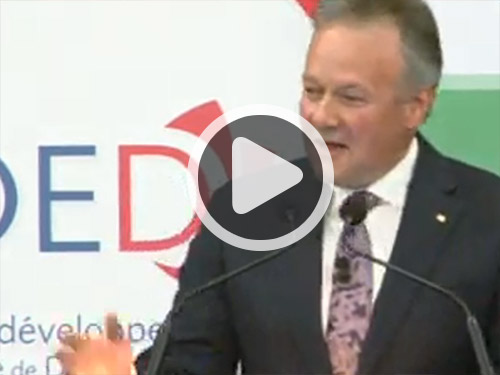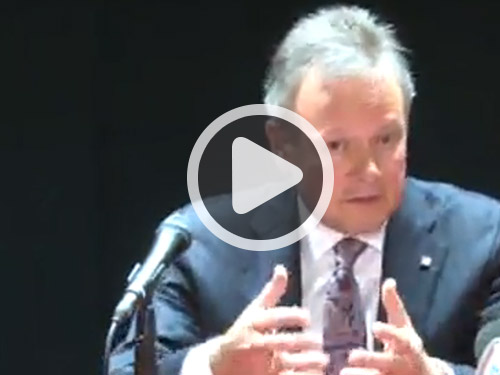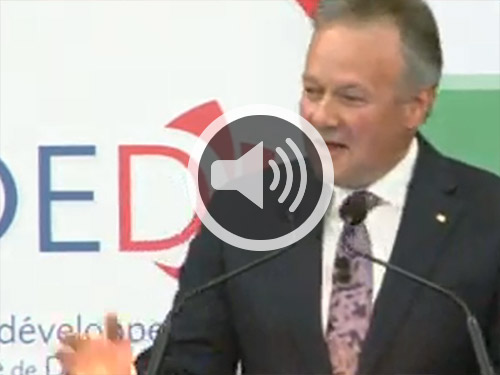Float of the Loonie
Introduction
Thank you for inviting me to be here with you today. It’s great to be back, but I guess you know I have changed jobs since I last saw you.
Companies in this region have gone through very difficult times in the wake of the global financial crisis - as have many across Canada. We’re in a better place now, but our economy is still not back to normal. So I appreciate the opportunity to come and meet with you to understand your situation better and share with you what’s on my mind.
As entrepreneurs, I’m sure you know that global trade has recovered only partially, as the world economy is still working through the fallout from the crisis. Compounding the issue for exporters, of course, has been the relative strength of the loonie. While it has come down in the past several months, it is still more than 40 per cent higher than it was in the early 2000s.
Many people in this room may be wondering why the Bank of Canada did not do more to limit the appreciation of the loonie, or to weaken it after it rose. After all, we have said time and again that stronger exports are needed to bring our economy home.
In my remarks today, I will do my best to answer that question. If I do my job well, you will leave with an understanding of why it’s a bad idea to try to manipulate exchange rates. I’ll give you some context and explain the role of the exchange rate in the Bank’s inflation-targeting framework. And I will talk about what we believe is needed to help our economy eventually return home, to balanced and sustainable growth.
Targeting Inflation: The Bank’s Best Contribution to Canada’s Economic Well-Being
The Bank of Canada’s mandate is to promote Canada’s economic and financial welfare. We do that by targeting inflation, as measured by the consumer price index. Our target range is 1 to 3 per cent, with the Bank's monetary policy aimed at keeping inflation at the 2 per cent target midpoint. In pursuing this target, we set in place the necessary conditions for strong, sustainable economic growth.
A low and stable inflation rate allows businesses and consumers to make financial decisions with confidence that the value of their money won’t be eroded by inflation. Parents can put money away to help their children with their education or for their own retirement without worrying that inflation will erase the real value of their savings. Businesses can plan expansions with reasonable forecasts of how inflation will affect what they will need for wages and investment.
The benefits of inflation control are confirmed by history. Since the adoption of the inflation-targeting regime in 1991, inflation has averaged very close to target, economic growth has been more stable, and unemployment has been lower and less variable. And, at the height of the crisis, our inflation-targeting regime and the credibility we have garnered over the years helped us weather the storm.
Riding the Tides of the Global Economy
Canada’s flexible exchange rate is an essential element of this monetary policy framework, as it helps us ride the tides of the global economy.
Our economy is open to the rest of the world. It must be, for we depend on sales to other countries to support our standard of living. We have a diversified export sector, but we depend more on exports of resources than most other advanced countries.
For that reason, our currency tends to move with commodity prices, which in turn move with rising or falling global demand. Indeed, we benefit from having a currency that rides the rising and falling tides of the global economy. It acts as a buffer. When the world economy is strong, commodity prices rise and our currency tends to float up to facilitate the adjustment of our economy. Similarly, when the world economy is weak, commodity prices fall, and our currency tends to float down.
It's like a floating breakwater across the mouth of a harbour that rises and falls with the tides, but absorbs the waves to help keep the water in the harbour calm.
Without a freely floating currency, prices, wages and unemployment could fluctuate markedly, and that would create havoc for people and businesses. A flexible exchange rate is essential for us to be able to pursue an independent monetary policy in the interests of Canada.
Let me illustrate with a “what-if?” scenario. Back in 2002, the Canadian dollar was worth around 65 cents U.S. By early 2008, it had risen to around parity. The world price of oil was about $25 per barrel in 2002, but by early 2008, that price had risen to well over $100.
It would be hard to imagine the Canadian dollar staying in the mid-60-cent range, given the rise in oil prices. As I’ve said before, there is a loose but predictable relationship between oil prices and our currency - like a dog and its master, when connected by one of those leashes that stretch and rewind.
But let’s just suppose we had tried to stop the Canadian dollar from rising once it reached around 85 cents, sometime in 2005.
The obvious way to limit the rise in the dollar would have been for the Bank to cut interest rates. Given the underlying upward pressure on the dollar coming from rising oil prices, we estimate that holding the loonie at around 85 cents back in 2005 would have required cutting interest rates from 4 per cent to almost zero.
As you would expect, the economy would then have two sources of stimulus - higher prices for oil exports and ultra-low interest rates, which would have boosted borrowing and spending.
This combination would have overheated our economy during 2006-08, and inflation would have begun to rise above our target. We estimate that inflation would have been approaching 4 per cent by 2008.
As an aside, let’s talk about what actually happened in 2008 - the global financial crisis. While it’s tricky to introduce a slice of reality into a hypothetical scenario, it is worth noting that if our interest rates were already near zero, we clearly would have had no room to manoeuvre.
But let’s set aside that complication, and finish our “what-if?” scenario. By 2008, inflation would have been approaching 4 per cent and still be rising. Your companies’ costs of production would have been rising by 4 per cent or more, and export competitiveness would be eroding steadily, even though we would be holding the exchange rate steady at 85 cents.
And that would not be the end of the story. With its anti-inflationary credibility increasingly at risk, the Bank would be forced into action - it would abandon its hypothetical attempt to control the dollar, interest rates would rise significantly to slow the excessive growth in the economy, unemployment would increase and inflation would eventually make its way back down to target. The exchange rate would have to find its own level at that point, because the Bank could not both target inflation and hold the exchange rate constant at the same time.
Although this is just a counterfactual thought experiment, it is informed by hard analysis. Trying to hold the dollar constant would give us larger fluctuations in unemployment, output and inflation, and in the end would not help us maintain our international competitiveness. It would also mean that we would have less policy credibility when it came time to take action during the financial crisis. In short, by targeting the exchange rate, we would lose our ability to pursue an independent monetary policy in the interests of Canada.
By the same token, we can imagine a scenario where the U.S. economy was picking up speed and our economy was lagging. In such a situation, U.S. interest rates might rise at a time when maintaining our inflation target would require that Canadian interest rates remain unchanged. If we were trying to hold the exchange rate unchanged instead of targeting inflation, we would probably need to match U.S. interest rate increases in lockstep; but doing so would risk pushing our inflation rate back below our target. Again, attempting to control the exchange rate would mean giving up our independent monetary policy.
Now, none of this means that we are indifferent to exchange rate movements. In fact, we closely analyze the effects of exchange rate movements on the economy. Our aim, however, is not to achieve a specific value for the dollar. It is to achieve our inflation target.
The best place for the exchange rate to be determined is in the markets. The markets trade the Canadian dollar toward a value consistent with the relative fundamentals of our economy and those of our trading partners. This trading happens around the clock, and new information is instantly taken into account by a multitude of participants. Markets are not perfect - they can overreact, or can break down in times of stress - but they are our best bet.
Some have argued that the Bank can have it both ways: it can use interest rates to pursue its inflation target, but independently intervene in the foreign exchange market to achieve a more desirable level for the dollar. This means buying and selling Canadian dollars in exchange for U.S. dollars in the open marketplace. But, given the depth of the global market, the Bank would need to undertake truly massive transactions to have even small effects on the exchange rate. Those effects would be very short-lived and, in the attempt, thwart the good work that markets do for us every day.
The only time when such direct intervention in markets might be practised would be in the case of a breakdown in the market, in which case the Bank could offer to transact on either side until normal trading resumed - in short, an emergency situation where the market fails for some reason.
Still others have suggested that the Bank could offer the exchange market verbal guidance about what the value of the dollar should be. Behind this suggestion is a presumption that the Bank has a better understanding of the macroeconomic fundamentals driving the dollar than the market. This is a difficult claim to defend. Our exchange rate depends on a host of domestic and foreign fundamentals, many of which are beyond the Bank’s influence. Better that these myriad effects be weighed, debated and wrestled with in a deep marketplace than in a simple statistical model developed by the central bank.
In short, I believe in markets. Manipulating or trying to guide them is just not in our game plan. What the Bank has done and will continue to do is be as clear as possible about how it sees the forces at play in the economy, and where the major sources of uncertainty and risks lie.
To bring this uncertainty more into the policy dialogue, we have made some changes in the past year to how we analyze and talk about monetary policy. Our efforts reflect the fact that the business of central banking is being adapted in real time to the changing environment.
We have begun putting our growth and inflation forecasts in the form of ranges rather than points, and have given even more prominence to uncertainty and risks in the Monetary Policy Report. We have refined our analysis of financial stability risks and raised the profile of our Financial System Review. And, we have begun to offer a more fulsome description of how those risks are entering our policy deliberations. These changes have brought more transparency to policy decision making, and our policy narrative has shifted from one traditionally seen almost as “mechanical engineering” to one now characterized as “risk management.”
Getting Home - A Natural Sequence
Let’s talk about that policy narrative now.
In the aftermath of the financial crisis, our export sector contracted significantly. The household sector picked up much of the slack in response to record-low interest rates, especially by investing in housing. But we cannot rely on policy-induced growth to maintain our living standards forever.
The Canadian economy requires a major rotation toward a more sustainable growth track. First, we need a substantial recovery in exports, Canada’s natural engine of economic growth. From that will follow more investment spending by companies, accompanied by more employment growth. All of this will help absorb our spare capacity, bringing inflation sustainably to our target of 2 per cent. And along the way, there will be a gradual reduction in our financial stability risks, such as household imbalances.
This is a natural sequence that we will monitor carefully. Its starting point, and the most critical ingredient, is a substantial recovery in exports.
Where will that critical revival of exports come from? Well, energy exports are already leading the way. This is the main source of natural growth in our economy today - new energy exports, new investment, new jobs. Furthermore, higher oil prices are boosting incomes across the entire country, and that creates jobs, too. But growth in energy exports alone cannot make up for the loss of exports we have experienced since the crisis.
Non-energy exports also will contribute, but they have been very sluggish for several years, at least until recently. After a weak start to the year, there has been a surge in non-energy exports in the past few months. About half of this rebound was weather-related, as exports were delayed during the winter. But underneath these fluctuations we are starting to see some early signs of recovery.
The fact is, though, that the global economy remains an uncertain place and, as forecasters, we are wary of the serial disappointment it has delivered us in recent years. Europe is obviously the biggest question mark. Nonetheless, the U.S. economy appears to be back on track and is now showing signs of higher investment spending, which is usually associated with stronger exports of Canadian machinery and equipment, packaging materials, industrial materials, and business services. Many of these sectors are also sensitive to exchange rate fluctuations, so the lower dollar is providing an additional boost to foreign sales.
Certainly, we should expect to see our forecast coming true right here in Drummondville, as this has always been an export-intensive part of the country. Companies here are investing to diversify their product lines and their customer bases and are positioning themselves for new growth. We now see the region’s traditional focus on textiles and furniture giving way to a broad range of technical, value-added manufacturing in machinery and equipment, building and packaging materials, and plastic and rubber products - some of the very sectors we expect to see leading our export recovery.
Nevertheless, some other export sectors have been struggling since well before the financial crisis. For them, the restructuring road is proving long and difficult, so some of the lost ground may only be made up over an extended period of time.
We can also expect to see brand-new export activity from newly created exporting firms. I’m sure I don’t have to remind this audience that many firms were wiped out in the crisis. Normally, as the economy gets back to full capacity, the overall population of businesses picks up and more firms enter the export markets, creating new products, new services and, most importantly, new jobs. Unfortunately, company population growth has been very sluggish since 2008, and preliminary data indicate this population did not increase at all in 2013.The ingredients are in place, however, so we remain hopeful that this process will resume in 2014-15.
All things considered, then, we are cautiously optimistic about our exporting future. It will take more than a few months to establish a trend, and then still longer for it to translate into more investment and hiring by companies, but it looks like the natural sequence we’ve been hoping for is getting under way.
Conclusion
Let me sum up. It is simply not possible to have a fulsome discussion of the outlook for Canada’s inflation rate and our monetary policy without an understanding of the effects the exchange rate is having on the economy.
But trying to control the loonie is off the table, as far as we are concerned at the Bank of Canada. A floating loon is a thing of beauty, and so is a floating loonie, at least from this economist’s perspective.
Our job is to understand the context, and adjust short-term interest rates to meet our inflation target. That job is tough enough. It is the job of the market to watch the economic data unfold and grind out the implications for other financial markets, including the exchange rate, on a daily basis. That, too, is a tough job, but it is not ours.
The fact is, the Bank can’t do its job well unless the market does its job well, and vice versa. And the Bank has been working to bring more transparency to the various elements of uncertainty that have been making its job more difficult, and this additional transparency is helping the market do a better job.
And all that is more than just talk - it means that business people like you can do a good job, too.


